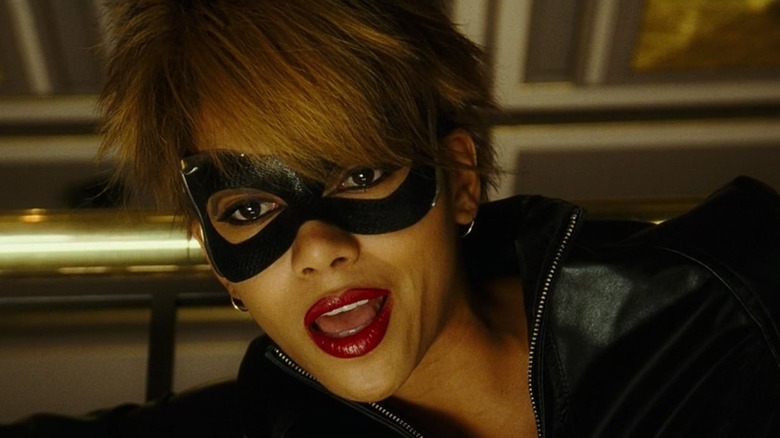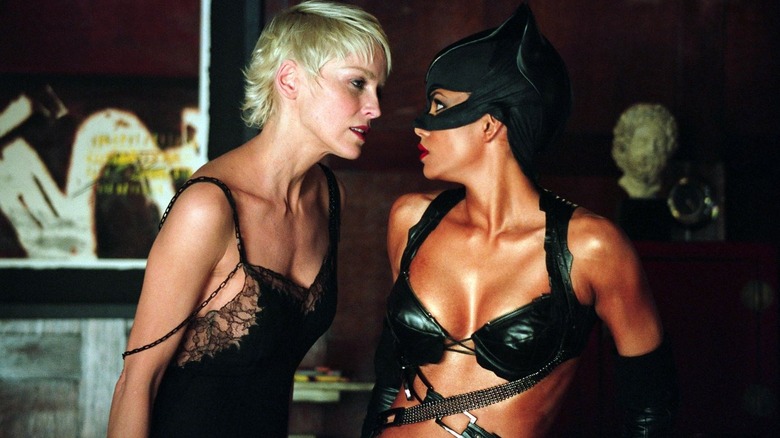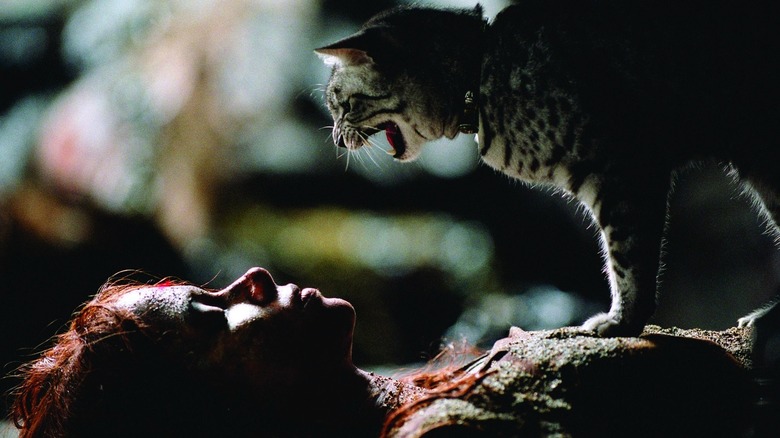Warner Bros. Had A Strict Batman Rule For Halle Berry's Catwoman Movie
When Tim Burton's "Batman Returns" was released in 1992, it was received with — to this author's recollection — a mixed amount of enthusiasm. The film was a hit, making over $266 million on an $80 million budget, but Burton's vision was described by critics and some audiences as being too odd. It was a bleak and strange film about how heroes and villains are indistinguishable, both of them bizarre freaks in a film noir world defined by entropy. The most notable character from "Batman Returns" was Catwoman, played by a vinyl-clad Michelle Pfeiffer. Indeed, the character was so popular that Warner Bros. semi-announced a "Catwoman" stand-alone feature in 1993, set to re-team Pfeiffer and Burton.
That feature never came together. The script, written by Daniel Waters, was considered too "adult," and by 1995, Pfeiffer had lost interest. For a brief moment, Ashley Judd was slated to take over the role, but she also dropped out. Eventually, Warner Bros. started to work on an ambitious 2004 superhero crossover called "Batman vs. Superman," but that project was canceled for being too expensive. In its place, the studio finally slotted in "Catwoman," a newly-realized project to star Halle Berry. That was the film that finally hit theaters that July.
"Catwoman" was rejected by audiences (making only $82 million on a $100 million budget) and received savage reviews — it has an 8% approval rating on Rotten Tomatoes. It was long held as one of the worst of all superhero movies, for both its clunky storytelling and vast departure from the comics on which it was based.
In July 2024, the makers of "Catwoman" reminisced on its making in an oral history published by EW. In it, they revealed the cardinal rule Warner Bros. mandated for their film. Namely: no Batman allowed.
Ceci n'est pas une cinéma du Batman
The story for the 2004 "Catwoman" film — directed by Pitof and written by John Brancato, Michael Ferris, and John Rogers — involves a wholly new character named Patience Phillips (Berry), previously unseen in the world of Batman comics. Patience, a meek soul, works as an ad designer for a gigantic cosmetics company that is secretly selling addictive and damaging skin creams to the public. When Patience discovers their secret, some evil security guys drown her in a drainpipe. Patience's body, however, is found by a magical cat (!) and revived. Patience soon finds she has catlike powers, and will eventually design her own vigilante costume to fight evil and uncover the evil dealings of her wicked boss Laurel (Sharon Stone).
None of this is taken from Batman comics. Catwoman is typically not a supernatural being. Which, it seems, was fine for Warner Bros. The studio wanted "Catwoman" to be a separate entity from the Batman universe, and any differentiation from the comics was a welcome alteration. Brancato said to EW:
"The interesting thing was all the rules handed to us from the first phone call: 'You can't mention Batman.' That was an absolute rule. [It was] a Warner Bros. corporate decision to keep this separate from the Batman universe."
Recall that there weren't many superhero movies in the mid-2000s that were designed to overlap with other superhero movies; that trend wouldn't begin (at least with this generation) until the inception of the Marvel Cinematic Universe in 2008. As such, Catwoman was the very first superhero in this universe. She existed without Batman.
Which, it seems, was fine by Berry.
Why not have Catwoman first?
Berry, even 20 years after the release of the film, felt that the filmmakers' approach wasn't a flaw, but a feature. It was fine, in her mind, to have a supernatural Catwoman in a world that didn't require Batman. It would force audiences to interact more directly with the character, and not concern themselves with her relationship to a male that defined the universe already. Let's kick the door down with a female character. We could concern ourselves with male characters after that.
"The beauty of doing it was because it wasn't in the Batman universe. Men, historically, get to have big franchises that revolve around them. This was an opportunity to be forward-thinking, pushing that envelope for women. Why can't we have our own superhero movie that revolves around us and our universe?"
It seems that Warner Bros. was a little, uh, two-faced when it came to the Batman-less mandate, however. WB said that the screenwriters couldn't allude to Batman, but also seemed a little scared to be making a Catwoman movie without Batman. Producer Denise Di Novi noted that WB would only grant so much leeway (and presumably advertising budget) for a film that didn't have a male lead at the center. Di Novi said:
"There was a lot of sexism involved. It was a female character. I pushed for it to be a feminist saga. I think [the studio] didn't fully embrace it because it was a female main character with no leading man."
From the sound of it, "Catwoman" was a film that Warner Bros. only greenlit under duress. They wanted to keep Batman alive but weren't willing to give the reins to a woman.
"Batman Begins" was released in 2005, though, so they got what they wanted.


